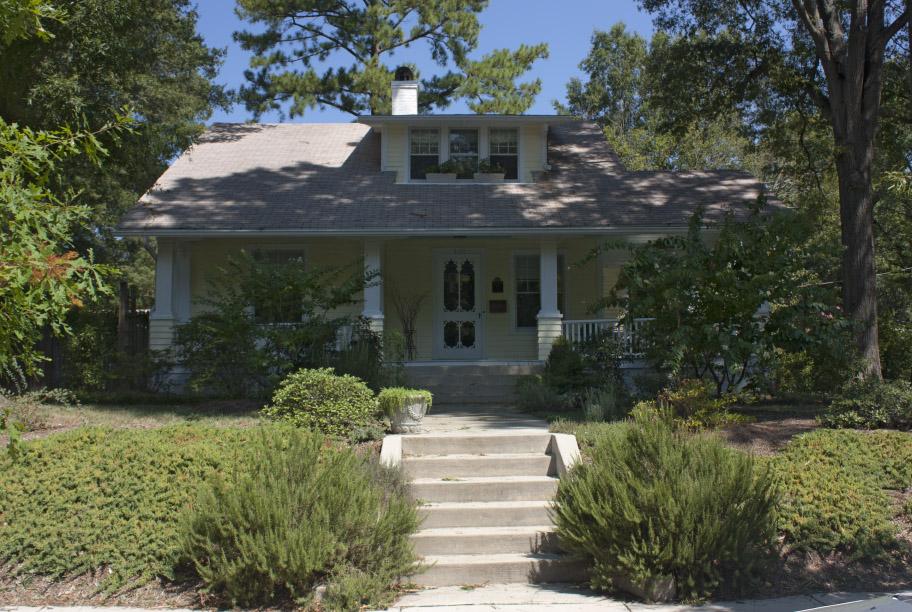08.28.11
(The information below in italics is from the Historic Preservation Society of Durham Plaque Application for the Clay-Lloyd House)
The story begins with Kurt and Linda Hube purchasing 2100 W. Club Blvd. in May of 2003, and renovating it under the guidelines of the NC Historic Preservation Society. They learned during this time that the house was in the Watts Hospital Hillandale Historic District and that the house had been named the R. D. Davis House. The first really important bit of information came from Myra Markham, a member of the NCHPS and one of Kurt's postal customers. She told him that a former neighbor of hers, Noble L. Clay, was the first owner of 2100 W. Club. Tom Miller, another person keenly interested in historic preservation and very active in the Watts Hospital-Hillandale Neighborhood Association, offered to show Kurt how to research some of the house's history using the Hills Directory and Durham Morning Herald at the Durham County Library. Research of Hills Directory revealed that, in fact, Noble L. Clay was the first resident of 2100 W. Club in 1917. R. D. Davis, after whom the house had been named, had rented a room in 2100 W. Club in 1925. Myra Markham knew that Noble Clay's nephew, Dr. Charles B. Johnson, still lived in the area and arranged for Kurt to make contact with him. This led to an interview with Dr. Charles B. Johnson and his wife Jean on 7/24/06. Dr. Johnson said that Noble Clay had never had children and that he and his brothers were treated as Noble Clay's own. As a youth, Dr. Johnson, growing up in Portsmouth, VA, visited the Clays at their home on Arnette St. in Durham during the summers. He came to Durham in 1946 to attend Duke and lived with the Clays until 1953. The following are some his recollections about Noble L. Clay.
Noble Clay was born in Norfolk, VA in 1889. As a young man he married Susie Johnson of Portsmouth, VA. He worked with the gas company in Norfolk, moved to Winston-Salem, then to Durham in about 1912. Noble was close friends with Cap Card, the first basketball coach at Duke (Trinity College), and they frequently played chess together. Noble coached basketball at Duke from 1913 to 1915, after which he officiated basketball games in this area. During his time in Durham, he was a superintendent with Carolina Power and Light Co. In the early 1920's Noble and his wife Susie moved to Florida because of a real estate boom in Florida at that time. In 1928, he went to Spain, to the island of Majorca, as VP of a gas and electric company. During his time there he served for a while as US Consulate to Majorca. In 1936 he was advised to leave Spain because of the Spanish Civil War, and he returned to Durham. While he was in Spain, Noble had done well financially and through a real estate agent in Durham had bought numerous properties here, where the economy was still recovering from the Great Depression. He bought a "strange shaped" building at Five Points downtown, apartments at Gregson and Demarius, the Ambassador Apts. on Trinity, the Erwin Apts. on Buchanan and Trinity, as well as other houses. He spent the rest of his life looking after his properties. He was chairman of the Planning and Zoning Commission of Durham for 20-25 years. He ran for City Council but lost (to James Sprunt Hill?). During WWII, he was on the board of directors of Durham Industrial Bank. In 1946-47, he and Susie bought a large cabin that would sleep 22 on Lake Michie. They went almost every weekend to the cabin and entertained there. The Clays traveled a lot, to South America and Europe. In 1939, they drove their old Pontiac to California for the Rose Bowl game in which Duke played. Noble was a member of St. Phillips Episcopal Church. Character wise, Dr. Johnson remembered Noble as being a generous man who did not display his wealth. Noble L. Clay died May 10, 1972, and Linda Hube found records on the internet of his being buried in Maplewood Cemetery.
Another opportunity for learning about 2100 W. Club's history came in an interview with Nancy Lloyd Mason and her husband, Walter R. Mason. Nancy's aunt Elise Lloyd Tandy bought 2100 W. Club in 1920. During the Depression the Hills Directory shows that Mrs. Tandy rented rooms out at 2100 W. Club. Hills Directory shows that in 1930, Mrs. Tandy lived in an apartment at 111 Watts St. while renting her home on Club. In 1932, Nancy Lloyd Mason's parent's Abbott E. and Eleanor T. Lloyd started living in the house. They purchased 2100 W. Club in 1942, and after Mr. Abbott E. Lloyd died in 1950, Mrs. Eleanor T. Lloyd lived there until she passed in 1978. At that point, Nancy's son Robert J. Mason and his wife Andrea bought and occupied the house until 1986. At this time, Nancy's second son Charles and his wife Tamara occupied 2100 W. Club and lived there until 2001. In summary, the Lloyd Tandy, Lloyd, Lloyd Mason, and Mason families owned 2100 W Club Blvd for 81 years between 1920 and 2001. The following are some of Nancy Lloyd Mason's recollections about where she grew up.
Nancy's grandfather started a hardware store, the Lloyd Hardware Co., in 1881. Her father Abbott E. Lloyd managed it until the Depression, when so few people were able to pay their bills that they went into bankruptcy. Later, Abbott worked 12 years for the Employment Security Commission of Durham. When the A. E. Lloyd family moved into 2100 in 1932 Nancy was in the 1st grade. The house was painted a mustard yellow. Its original roofing was cedar shake shingles painted green, after which green octagonal asphalt shingles were put on the roof. The house was heated with a coal furnace, the heat rising up through a grate in the center of the house. During WWII Mr. Lloyd would complain about how much "junk" (rocks, etc.) was in a load of coal. One of Nancy's chores as a child was to bring coal up from the basement to be used in the coal fireplaces and the coal stove in the downstairs bedroom. Upstairs, woodstoves were attached to the flues in each bedroom. Nancy has very fond memories of growing up in the house. There were lots of children in the neighborhood with whom to play. The area had been Hester Farm and it was very hot because there were no shade trees. The trees along Club were planted by the WPA in 1933-34, and A. E. Lloyd planted the currently existing large shade trees in the yard. Mr. Lloyd called the house "Skeeter Hurst" because there were so many mosquitoes at that time. Also noted was that there was a creek bed nearby, in the 2000 block of W Club, down which Erwin Mills ran dyes that gave off a bad smell. Another nickname that was given, to the front porch, was "the neckatorium" because of the courting that took place there. Nancy recalled that the coffered ceilings and other trim work in the living and dining rooms were a natural wood color and gave the effect of "cutting the rooms up into a thousand pieces". When she was a little girl, the light fixture in the dining room was a gas fixture that hung so low one had difficulty walking under it. The current light fixtures in the living and dining rooms were put in by her mother, Eleanor T. Lloyd, in the 1940's. The original lot was 250 ft. deep. In 1958, Nancy's brother used 81 ft. off the back of the property to build a house. Prior to this that area was a vegetable and flower garden. The Lloyds would have a man with a horse come to plow it and afterwards they would often find arrowheads. After Eleanor T. Lloyd passed away in 1978, Bob and Andrea Mason bought 2100 W. Club. During their ownership, they did extensive interior remodeling. They remodeled the kitchen and both bathrooms and rewired the house. Bob added central heat and air conditioning and, using attic space, added a large closet to the main bedroom upstairs. Nancy's husband Walter recalled that Eleanor T. Lloyd had painted the entire downstairs blue, including the original wood fireplace mantels (one mahogany, the other, oak). Walter removed all the blue paint from the mantels after Bob and Andrea moved in.
Kurt and Linda Hube wish to thank Dr. Charles B. Johnson and his wife Jean, and Nancy Lloyd Mason and her husband Walter for sharing their wonderful stories about the history of 2100 W. Club Blvd. and its occupants.
R. D. Davis House.
Substantial 1 1/2-story plain-sided bungalow has a side-gabled roof with deep eaves, a shed dormer with a recessed balcony, and 12-over-1 and 9- over-1 sash windows. The engaged wrap-around porch features paneled posts with decorative porch brackets and a plain railing. The Craftsman door is glazed and paneled.
1925 CD: R. D. Davis & Mrs. L. C. Hutchins, occupants.


Add new comment
Log in or register to post comments.